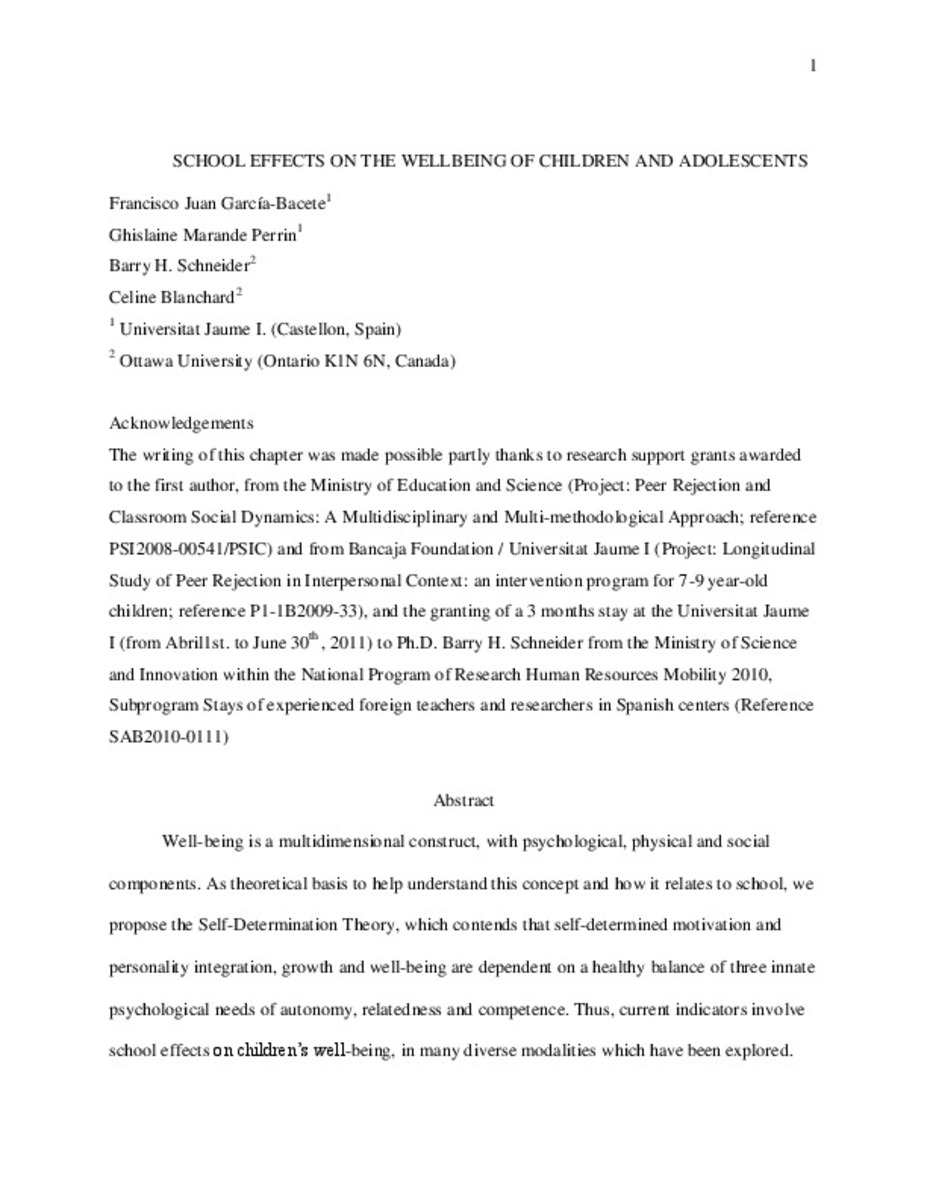Mostrar el registro sencillo del ítem
School Effects on the Wellbeing of Children and Adolescents
| dc.contributor.author | García Bacete, Francisco Juan | |
| dc.contributor.author | Marande Perrin, Ghislaine | |
| dc.contributor.author | Schneider, Barry H. | |
| dc.contributor.author | Blanchard, Celine | |
| dc.date.accessioned | 2017-09-05T10:56:47Z | |
| dc.date.available | 2017-09-05T10:56:47Z | |
| dc.date.issued | 2014 | |
| dc.identifier.citation | García Bacete, F. J., Marande, G., Schneider, B.H., y Blanchard, C. (2014). School Effects on the Wellbeing of Children and Adolescents. En A. Ben-Arieh, F. Casas, I. Frones y J. E. Korbin (Eds.), Handbook of Child Well-Being. Theories, Methods and Policies in Global Perspective 3 (p. 1251-1305). New York: Springer | ca_CA |
| dc.identifier.isbn | 978-90-481-9063-8 | |
| dc.identifier.uri | http://hdl.handle.net/10234/168568 | |
| dc.description.abstract | Well-being is a multidimensional construct, with psychological, physical and social components. As theoretical basis to help understand this concept and how it relates to school, we propose the Self-Determination Theory, which contends that self-determined motivation and personality integration, growth and well-being are dependent on a healthy balance of three innate psychological needs of autonomy, relatedness and competence. Thus, current indicators involve school effects on children’s well-being, in many diverse modalities which have been explored. Some are described in this chapter, mainly: the importance of peer relationships; the benefits of friendship; the effects of schools in conjunction with some forms of family influence; the school climate in terms of safety and physical ecology; the relevance of the teacher input; the school goal structure and the implementation of cooperative learning. All these parameters have an influence in promoting optimal functioning among children and increasing their well-being by meeting the above mentioned needs. The empirical support for the importance of schools indicates significant small effects, which often translate into important real-life effects as it is admitted at present. The conclusion is that schools do make a difference in children’s peer relationships and well-being. | ca_CA |
| dc.format.extent | 86 p. | ca_CA |
| dc.format.mimetype | application/pdf | ca_CA |
| dc.language.iso | eng | ca_CA |
| dc.publisher | Springer Netherlands | ca_CA |
| dc.relation.isPartOf | Handbook of Child Well-Being. Theories, Methods and Policies in Global Perspective, v. 3 | ca_CA |
| dc.rights | © Del texto: los autores | |
| dc.rights.uri | http://rightsstatements.org/vocab/InC/1.0/ | * |
| dc.title | School Effects on the Wellbeing of Children and Adolescents | ca_CA |
| dc.type | info:eu-repo/semantics/bookPart | ca_CA |
| dc.identifier.doi | http://dx.doi.org/10.1007/978-90-481-9063-8_149 | |
| dc.rights.accessRights | info:eu-repo/semantics/openAccess | ca_CA |
| dc.relation.publisherVersion | https://link.springer.com/referenceworkentry/10.1007/978-90-481-9063-8_149 | ca_CA |
| dc.type.version | info:eu-repo/semantics/submittedVersion | ca_CA |
Ficheros en el ítem
Este ítem aparece en la(s) siguiente(s) colección(ones)
-
PSI_Capítols de llibres [39]
Capítols de llibres escrits per professors del Departament







